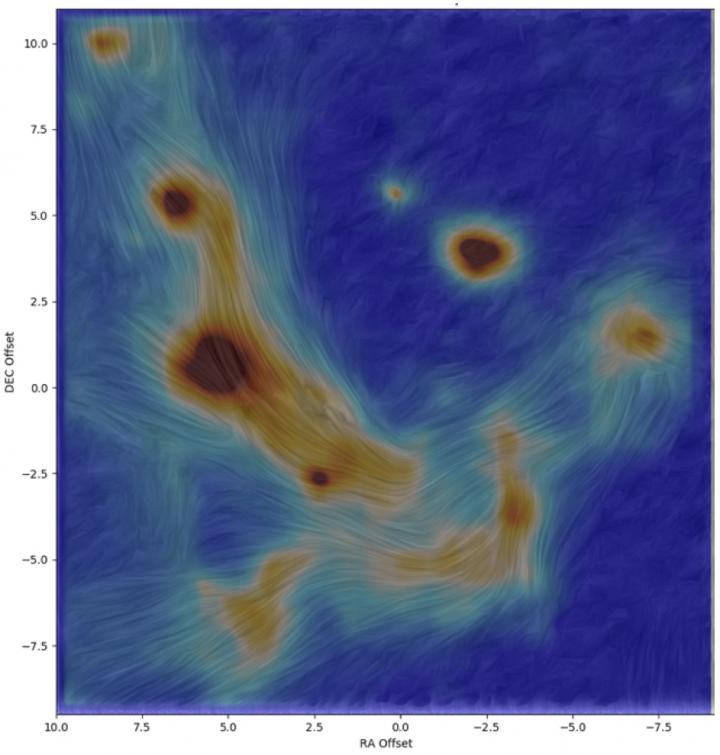New research reveals clearest infrared image yet of the center of our galaxy

This image is a new high-resolution map of the magnetic field lines in gas and dust swirling around the supermassive black hole at the center of our galaxy. Credit: Oxford University/Royal Astronomical Society/UTSA
“This collaborative work is an exciting step forward in our collective efforts to gain a greater understanding of our own galaxy and the super-massive black hole at the center of it. It also demonstrates the importance of access to the largest telescopes using advanced cameras/techniques,” Packham said.
Black holes are objects with gravitational fields so strong that even light cannot escape their grasp. The center of almost every galaxy appears to host a black hole, including the Milky Way, where we live. Stars move around the black hole at speeds of up to 800 million kilometres an hour, indicating that it has a mass of at least a million times our Sun. Depending on how the material flows, some of it may eventually be captured and engulfed by the black hole.
Visible light from sources in the center of the Milky Way is blocked by clouds of gas and dust. Infrared light, as well as X-rays and radio, more freely passes through this obscuring material, so astronomers use this to see the region more clearly. CanariCam combines this with a polarising device, which preferentially filters light with the particular characteristics associated with magnetic fields.
“This work, in addition to its scientific relevance, is very important to the advancement of the Ph.D. physics and astronomy program here at UTSA, since it involves students in cutting edge research,” said Miguel Jose Yacaman, professor and Lutcher Brown Endowed Chair of the UTSA Department of Physics and Astronomy.
Centered on the supermassive black hole, the new infrared map covers a region about one light year on each side. The image shows the intensity of infrared light, and traces magnetic field lines within filaments of warm dust grains and hot gas, which appear here as thin lines reminiscent of brush strokes in a painting.
The filaments, several light years long, appear to meet close to the black hole and may indicate where orbits of streams of gas and dust converge. One prominent feature links some of the brightest stars in the center of the galaxy. Despite the strong winds flowing from these stars, the filaments remain in place, bound by the magnetic field within them. Elsewhere the magnetic field is less clearly aligned with the filaments.
The new observations give astronomers more detailed information on the relationship between the bright stars and the dusty filaments. The origin of the magnetic field in this region is not understood, but it is likely that a smaller magnetic field is stretched out as the filaments are elongated by the gravitational influence of the black hole and stars in the galactic center.
“Big telescopes like GTC, and instruments like CanariCam, deliver real results,” Roche said. “We're now able to watch material race around a black hole 25,000 light years away, and for the first time see magnetic fields there in detail.”
Media Contact
All latest news from the category: Physics and Astronomy
This area deals with the fundamental laws and building blocks of nature and how they interact, the properties and the behavior of matter, and research into space and time and their structures.
innovations-report provides in-depth reports and articles on subjects such as astrophysics, laser technologies, nuclear, quantum, particle and solid-state physics, nanotechnologies, planetary research and findings (Mars, Venus) and developments related to the Hubble Telescope.
Newest articles

Trotting robots reveal emergence of animal gait transitions
A four-legged robot trained with machine learning by EPFL researchers has learned to avoid falls by spontaneously switching between walking, trotting, and pronking – a milestone for roboticists as well…

Innovation promises to prevent power pole-top fires
Engineers in Australia have found a new way to make power-pole insulators resistant to fire and electrical sparking, promising to prevent dangerous pole-top fires and reduce blackouts. Pole-top fires pose…

Possible alternative to antibiotics produced by bacteria
Antibacterial substance from staphylococci discovered with new mechanism of action against natural competitors. Many bacteria produce substances to gain an advantage over competitors in their highly competitive natural environment. Researchers…





















